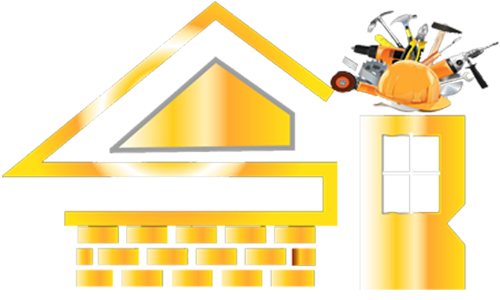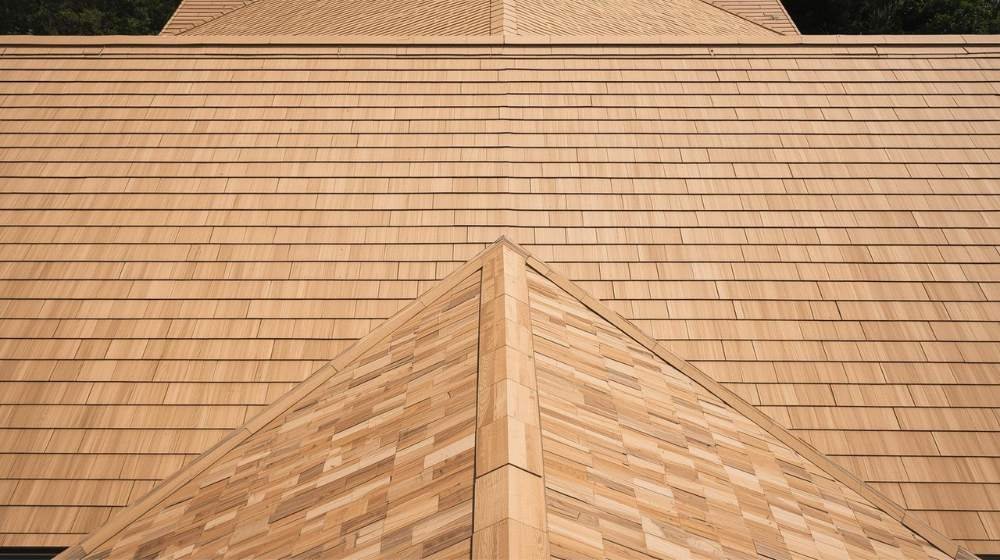
Are you considering a wood shingles roof for your home? If so, you’re probably wondering about its benefits, durability, and cost. A wood shingle roof is always beautiful and has a natural charm, but is it the right choice for you? In this blog post, we’ll discuss everything you need to know.
We will cover the basics of wood shingles, the different types available, and the pros and cons of choosing them for your roof. We’ll also explore how to install and maintain wood shingles, what you can expect to pay, and how they compare to other roofing materials. This guide provides clear and useful information to help you make an informed decision, whether you’re a homeowner or planning a renovation.
Let’s get started and look at all the information you need to know about wood shingles!
Key Information on Wood Shingle Roofs
- Wood Shingle Roof: Made from thin, flat wood pieces like cedar, pine, or redwood.
- Wood Shingle Components: Includes shingles, underlayment, ridge cap, starter course, flashing, ventilation, nails, fascia, drip edge, and roof deck.
- Cedar Shingles: Durable, lightweight, resistant to rot, and offer excellent insulation with a 30-50 year lifespan.
- Pine Shingles: Affordable, less durable than cedar, and lasts 20-30 years with treatment.
- Redwood Shingles: Luxurious, resistant to decay, and last 30-50 years with proper care.
- Cypress Shingles: Eco-friendly, decay-resistant, and lasting 25-40 years.
- Douglas Fir Shingles: Strong, suitable for harsh climates, and lasts 20-30 years with maintenance.
- Alaskan Yellow Cedar Shingles: Durable, moisture-resistant, lifespan: 40-50 years, ideal for wet climates.
- Wood Shingles Pros: Eco-friendly, durable, insulating, and adds aesthetic charm.
- Wood Shingles Installation Cost: Costs $9-$16 per sq. ft. in Brooklyn. It depends on the wood type.
What is a wood shingle roof?
A wood shingle roof is a type of roofing made from thin, flat pieces of wood, typically cut from cedar, pine, or redwood. These shingles are installed in overlapping rows to protect the roof from rain, snow, and other weather conditions. Wood shingles offer a natural, rustic appearance that enhances the charm of any home. They are durable, eco-friendly, and offer good insulation. Wood shingles are often chosen for their aesthetic appeal and long-lasting qualities.
What are the components, accessories, and parts of wood shingles?
Wood shingles don’t work alone. They need specific components and accessories to ensure proper installation and function. Here are the key parts that come together to make a wood shingle roof:
- Shingles: The primary component is cut from wood like cedar, redwood, or pine. They provide the main protection from weather elements.
- Underlayment: A layer placed under the shingles for additional water resistance. It prevents water from seeping into the roof deck.
- Ridge Cap: Covers the peak of the roof. It ensures water doesn’t enter through the top and seals the shingles together.
- Starter Course: The first row of shingles is installed at the base of the roof. It provides a foundation for the rest of the shingles.
- Flashing: Metal pieces installed around roof edges and openings. They help prevent water from leaking into the roof.
- Ventilation: Roof vents allow air circulation to prevent moisture buildup. Proper ventilation extends the life of the shingles.
- Nails: Special roofing nails secure the shingles to the roof. These nails are durable and designed for outdoor use.
- Fascia: The trim along the roof’s edge. It supports the shingles and adds to the roof’s appearance.
- Drip Edge: Installed at the roof’s edge to direct water away. This helps protect the roof and walls from water damage.
- Roof Deck: The base layer beneath all roof components. It supports the shingles and holds everything in place.
What are the Different Types of Wood Shingles?
Wood shingles come in various types. It depends on the wood used and the style of cut. Each type has its own benefits and characteristics, which give homeowners many options to choose from. Here are six common types of wood shingles:
Cedar Shingles
Made from cedar wood, these shingles are the most popular choice. They are naturally resistant to moisture, rot, and insects, which makes them durable and long-lasting. Cedar shingles offer a rich, warm color that fades to a beautiful gray over time.
- Material: Made from Western Red Cedar or Eastern White Cedar.
- Color: Initially a rich reddish-brown, which fades to a grayish-silver over time.
Features:
- Naturally resistant to rot, insects, and moisture.
- Lightweight and easy to install.
- Provides excellent insulation.
- Known for its aesthetic appeal with a rustic, natural look.
- Lifespan: Typically lasts 30-50 years with proper maintenance.
- Ideal For: Homeowners seeking an eco-friendly, durable, and beautiful roof with a classic appeal.
Pine Shingles
Pine shingles are an affordable option for roofing. They have a light yellow or pale brown appearance and are easy to work with. Though less durable than cedar, treated pine shingles can last for many years.
- Material: Made from Southern Yellow Pine or Eastern White Pine.
- Color: Light yellow to pale brown.
Features:
- Affordable compared to other wood options.
- Relatively soft wood, making it easier to work with.
- When treated, it can be resistant to rot and insects.
- Lifespan: Around 20-30 years, a shorter lifespan compared to cedar.
- Ideal For: Budget-conscious homeowners who still want a natural wood look.
Redwood Shingles
Made from redwood, these shingles have a deep reddish-brown color. They are naturally resistant to decay and insects, providing long-lasting protection. Redwood shingles are ideal for those looking for a luxurious look and feel.
- Material: Made from redwood trees.
- Color: Deep reddish-brown with a smooth finish.
Features:
- Naturally resistant to decay and insects.
- Known for its luxurious, elegant look.
- Durable and resistant to warping or cracking.
- Lifespan: Lasts 30-50 years, depending on the level of maintenance and climate conditions.
- Ideal for homeowners seeking a premium, aesthetically pleasing roofing material with exceptional durability.
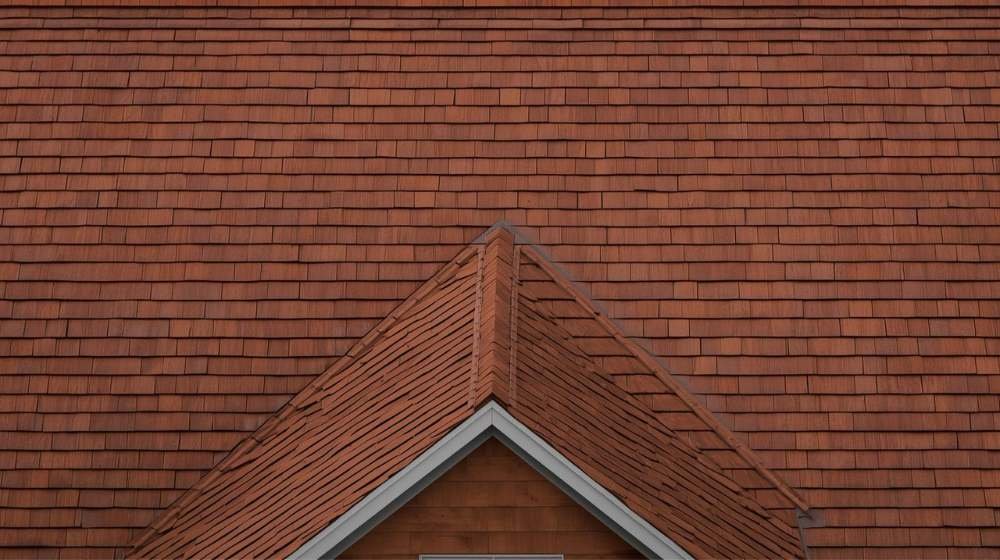
Cypress Shingles
Known for its light brown to yellowish color, cypress wood is naturally resistant to decay. These shingles are a great option for those seeking a sustainable, eco-friendly roofing material. Cypress shingles are durable and can withstand harsh weather conditions.
- Material: Made from Cypress wood.
- Color: Light brown to yellowish-brown.
Features:
- Eco-friendly and renewable, with low environmental impact.
- Naturally resistant to rot and insects due to natural oils in the wood.
- Offers good weather resistance in both humid and dry climates.
- Lifespan: Lasts 25-40 years, with periodic maintenance.
- Ideal For: Those seeking a sustainable and resilient roofing material with a natural, rustic appearance.
Douglas Fir Shingles
Douglas Fir shingles are strong and sturdy, often used in areas with harsher climates. They have a light brown color with a fine grain. While not as resistant to rot as cedar, Douglas fir shingles can last a long time with proper maintenance.
- Material: Made from Douglas Fir wood.
- Color: Light brown with a fine, straight grain.
Features:
- Strong and sturdy, often used in areas with harsh climates.
- Less resistant to rot compared to cedar or redwood but still durable when treated.
- Has a smooth texture and adds a clean, neat finish.
- Lifespan: Typically lasts 20-30 years, with proper care.
- Ideal For: Homes in areas that require a tough, sturdy material but can manage routine maintenance.
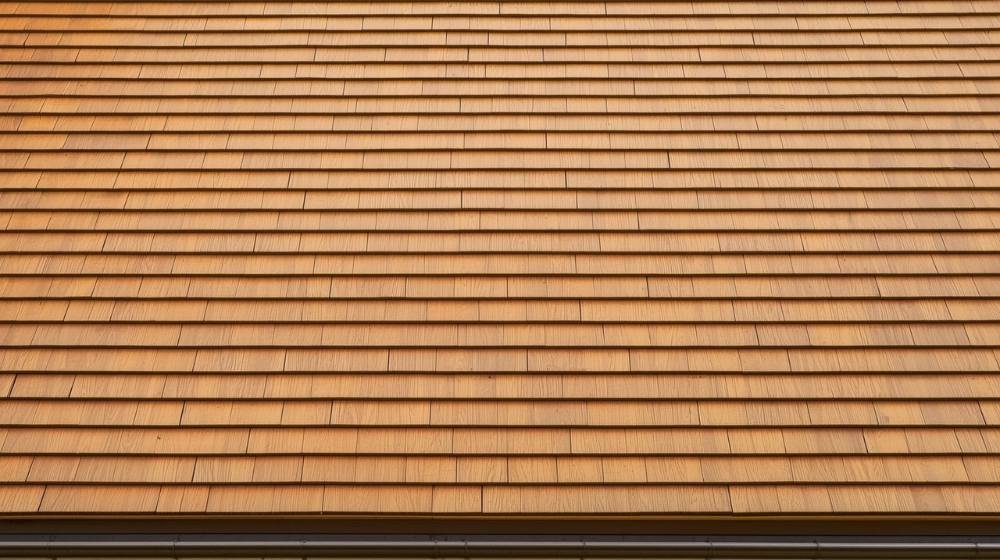
Alaskan Yellow Cedar Shingles
These shingles are made from Alaskan Yellow Cedar, a very durable and moisture-resistant wood. The light yellow color of these shingles gives a unique aesthetic to the roof. They are ideal for regions with high moisture or rainy climates due to their resistance to decay.
- Material: Made from Alaskan Yellow Cedar.
- Color: Light yellow to pale tan.
Features:
- Highly durable and moisture-resistant, making it perfect for regions with high rainfall.
- Resistant to decay and insects due to the wood’s natural properties.
- Offers a unique, bright aesthetic that enhances curb appeal.
- Lifespan: Known for lasting 40-50 years or more, especially in wet climates.
- Ideal For: Coastal homes or areas with wet, humid conditions, looking for a durable, long-lasting wood roofing option.
Pros and Cons of Wood Shingles
It’s important to know the pros and cons of wood shingles to make an informed decision before installing them on your roof. Understanding both the benefits and drawbacks helps you to make the right decision. This knowledge also helps with proper maintenance and ensures the longevity of your roof.
Benefits of Wood Shingles
- Aesthetic Appeal: Wood shingles give your roof a natural, classic look. The warm tones of wood add charm and beauty to any home. They also develop a unique grayish-silver patina as they get older. It enhances their rustic charm.
- Eco-Friendly: Wood is a renewable resource, which makes wood shingles an environmentally friendly choice. They are biodegradable, which helps reduce waste. If you choose responsibly sourced wood, it can contribute to sustainability.
- Durability: Wood shingles, especially those made from cedar or redwood, are naturally resistant to rot and insects. This makes them durable and long-lasting. With proper maintenance, they can last 30 to 50 years.
- Insulation: Wood shingles offer natural insulation. It keeps your home cool in the summer and warm in the winter. The wood helps regulate indoor temperatures by acting as a barrier. This can lead to energy savings over time.
- Fire Resistance (when treated): Cedar and redwood shingles are naturally fire-resistant when properly treated and maintained. Fire-resistant treatments add an extra layer of protection. This can be especially important in areas prone to wildfires.
- Energy Efficiency: Wood shingles have a natural ability to reflect heat. It reduces the amount of heat that enters your home. This keeps your home cooler, especially in sunny climates. It can lower your energy bills by reducing the need for air conditioning.
Disadvantages of Wood Shingles
- Higher Initial Cost: Wood shingles tend to be more expensive than other roofing materials, such as asphalt. The cost of materials and labor for installation might be high. Before making a choice, consider how it will impact your budget.
- Maintenance: Wood shingles require regular maintenance to prevent issues such as moss growth and rot. You’ll need to clean and treat them every few years to prolong their lifespan. Without proper care, their durability can be reduced.
- Vulnerability to Weather: Wood shingles can be damaged by extreme weather, like heavy storms or hail. Excessive moisture can cause them to warp, crack, or decay. In areas with heavy rain or snow, this can be a significant concern.
- Fire Hazard: Although treated wood shingles are fire-resistant, untreated shingles are highly flammable. Fire safety rules may require extra steps to be taken in homes that are at risk of wildfires. It’s important to choose fire-treated wood for added protection.
- Weight: Wood shingles are heavier than other roofing materials, like asphalt or metal. This may require additional structural support for your roof. If your roof is not properly reinforced, it could lead to damage over time.
- Limited Color Options: Unlike other materials, wood shingles have a natural color range, mainly from brown to gray. If you want a roof with specific colors, wood shingles may not offer the variety you’re looking for. However, staining can give some control over the appearance.
How to Install Wood Shingles
Wood shingle installation requires precision and careful planning to ensure proper coverage and longevity. By following the correct steps, you can achieve a sturdy and visually appealing roof. Here’s a simple step-by-step guide to installing wood shingles:
- Step 1: Prepare the Roof Deck:Start by ensuring the roof deck is clean and in good condition. Repair any damaged sections before installation. A smooth, clean surface helps secure the shingles properly in place.
- Step 2: Install Underlayment: Lay down a waterproof underlayment to protect the roof from moisture. This layer prevents water from seeping into the roof deck. Overlap the edges to ensure proper coverage.
- Step 3: Install the Starter Course:Begin at the roof’s edge with a starter course of shingles. This first row acts as a base for the rest of the shingles. Make sure each shingle is securely fastened.
- Step 4: Lay the First Row of Shingles:Start laying the first full row of shingles above the starter course. Overlap each shingle by about 1 to 1.5 inches to prevent water penetration. Use roofing nails to secure them in place.
- Step 5: Stagger the Shingles: For a neat and waterproof finish, stagger the seams between rows. This ensures that no two shingles meet at the same spot. Staggering creates a more secure roof.
- Step 6: Install Ridge Cap: After installing the shingles, add a ridge cap along the roof’s peak. This covers the top and seals the roof against wind and rain. It also provides a clean finish to the roof’s edges.
- Step 7: Final Inspection: After installation, inspect the roof for any loose shingles or gaps. Ensure all edges are properly sealed, and no nails are visible. A final check ensures a secure and sturdy roof.
How Much Do Wood Shingles Cost (per sq. ft.) in Brooklyn, NYC?
In Brooklyn, NYC, the average cost of wood shingle roofing ranges from $9 to $16 per square foot. It depends on the type of wood and quality. For instance, white cedar shingles are more affordable, whereas red cedar shingles with fire-resistant treatments can be more expensive. Installation costs also vary based on the complexity of the roof and the contractor’s rates. It’s essential to obtain multiple quotes to ensure competitive pricing.
Wood Shingles Installation Cost (per sq. ft.)
Here’s an estimate of the installation cost of different types of wood shingles. The table below shows the material cost, labor cost, and total cost for each type of wood shingle.
| Wood Shingles Type | Materials Cost | Labor Cost | Total Cost |
| Cedar Shingles | $5 – $9/sq ft | $4 – $7/sq ft | $9 – $16/sq ft |
| Red Cedar Shingles | $7 – $12/sq ft | $5 – $8/sq ft | $12 – $20/sq ft |
| Cypress Shingles | $6 – $10/sq ft | $5 – $7/sq ft | $11 – $17/sq ft |
| Pine Shingles | $4 – $8/sq ft | $3 – $6/sq ft | $7 – $14/sq ft |
| Douglas Fir Shingles | $6 – $10/sq ft | $4 – $7/sq ft | $10 – $17/sq ft |
| Alaskan Yellow Cedar | $9 – $14/sq ft | $6 – $9/sq ft | $15 – $23/sq ft |
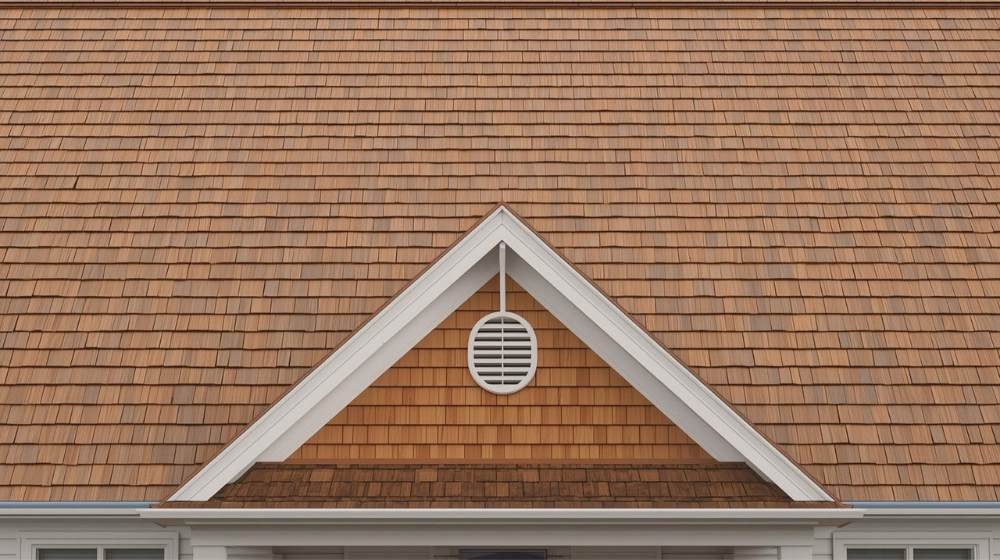
How to Repair a Wood Shingle Roof
A wood shingle roof repair is a straightforward process, but it requires attention to detail. If you notice missing or damaged shingles, timely repair can prevent further issues.
- Step 1: Inspect the Roof: Start by inspecting the entire roof for damaged, cracked, or missing shingles. Look for signs of rot, mold, or any noticeable wear. It’s crucial to inspect after a storm or heavy weather.
- Step 2: Remove the Damaged Shingles:Use a hammer and chisel to carefully lift and remove the damaged shingles. Avoid damaging the surrounding shingles to maintain the roof’s integrity. If needed, replace multiple shingles at once to prevent further damage.
- Step 3: Measure and Cut the Replacement Shingle:Measure the space where the new shingle will go and cut the replacement to fit the size. Ensure the new shingle is the same thickness and style as the old one for uniformity. This will help maintain the roof’s appearance and protection.
- Step 4: Install the New Shingle: Place the new shingle in the gap and secure it with roofing nails. The nails should be driven at an angle to ensure they grip the shingle properly. Ensure the new shingle overlaps the one below it to ensure proper water runoff.
- Step 5: Seal the Shingle Edges: Apply roofing cement or sealant underneath the edges of the new shingles. This helps secure it tightly and prevents water from seeping in. Ensure the sealant covers all vulnerable spots where water could enter.
- Step 6: Final Check: After installation, inspect the area for any gaps or loose shingles. Ensure that all shingles are properly aligned and secure. A final check helps ensure the roof is fully sealed and ready to protect your home.
Comparison of Wood Shingles with Other Roofing Materials
The right roofing material selection can be a challenge, as each type offers different benefits. Below is a comparison of wood shingles with other popular roofing materials based on five key factors: cost, durability, maintenance, aesthetic appeal, and fire resistance.
| Roofing Material | Cost (per sq. ft.) | Durability | Maintenance | Aesthetic Appeal | Fire Resistance |
| Wood Shingles | $9 – $16 | 30 – 50 years | Moderate | Natural, rustic look | Moderate (treated) |
| Asphalt Shingles | $3 – $5 | 15 – 30 years | Low | Uniform, modern | High (Class A rating) |
| Metal Roofing | $10 – $18 | 40 – 70 years | Low | Sleek, modern | Very high (non-combustible) |
| Slate Roofing | $20 – $40 | 50 – 100+ years | High | Elegant, classic | Very high (non-combustible) |
| Tile Roofing | $10 – $25 | 50+ years | Moderate | Traditional, varied | High (non-combustible) |
| Wood Shake Shingles | $10 – $20 | 30 – 50 years | High | Rustic, textured look | Low (without treatment) |
Additional Information
What is Wood Shingle Siding?
Wood shingle siding is a type of exterior cladding made from thin, flat pieces of wood, typically cedar or redwood. The shingles are installed in overlapping rows to cover the exterior walls of a building. This style of siding gives a home a natural, rustic appearance that complements many architectural designs. Wood shingle siding also provides some natural insulation. It helps with energy efficiency. It requires regular maintenance to protect it from rot, weathering, and pests.
What are Wood Shake Shingles?
Wood shake shingles are a type of roofing and siding material made from hand-split wood, typically cedar or redwood. They have a rougher, more textured appearance compared to wood shingles, which are machine-cut.
Features of Wood Shake Shingles:
- Hand-Split Texture: Provides a more rugged, rustic appearance than machine-cut shingles.
- Thicker and Durable: Shakes are thicker and more resistant to weathering.
- Longevity: Wood shakes last longer than regular wood shingles with proper maintenance.
- Moisture Resistance: Typically, more resistant to moisture and decay compared to wood shingles.
- Natural Aesthetic: Gives a more traditional and natural look to roofing or siding.
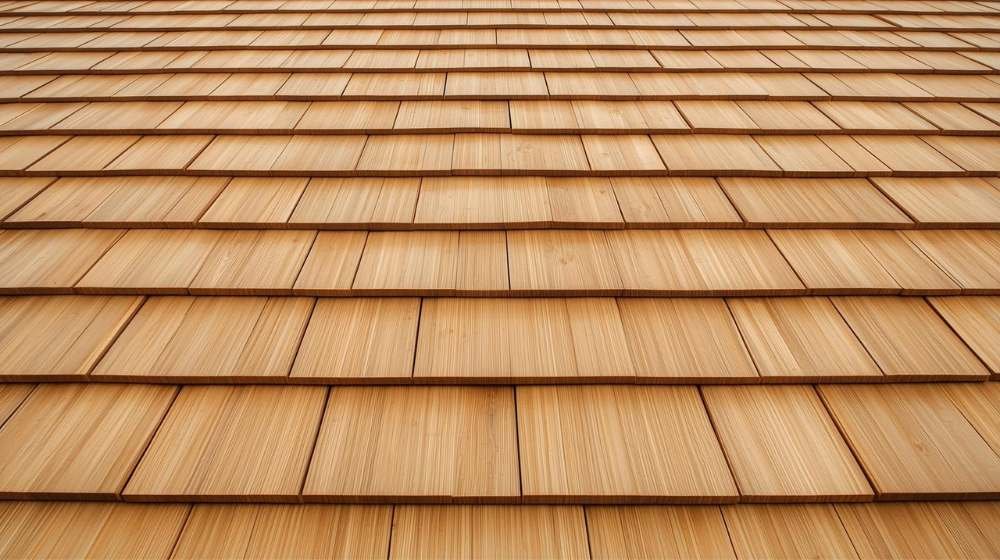
What’s the Difference Between a Wood Shingle and a Wood Shake Roof?
Wood shingles and wood shakes may appear similar, but they differ in their manufacturing process, overall appearance, and durability. This table compares the key differences between the two:
| Factor | Wood Shingles | Wood Shakes |
| Manufacturing | Machine-cut, smooth and uniform | Hand-split, rough and uneven |
| Thickness | Thinner and more uniform | Thicker and bulkier |
| Appearance | Smooth, neat finish | Rugged, rustic appearance |
| Durability | Moderate, can be less durable in harsh weather | Longer-lasting, better resistant to weathering |
| Maintenance | Requires regular maintenance | Requires more maintenance but lasts longer |
What are Weathered Wood Shingles?
Weathered wood shingles are shingles that have aged over time due to exposure to the elements. This aging process causes the wood to fade to a grayish-silver color, which gives it a natural, rustic look. The shingles still provide the same protection as new ones but have a distinct, weathered appearance. Many homeowners choose weathered wood shingles for their aesthetic appeal, especially in coastal or country-style homes.
Weathered Wood Shingle Colors
- Silver-Grey: A soft, weathered gray look, commonly seen in older wood shingles. This color adds a classic appearance to the roof or siding.
- Charcoal Grey: A darker gray color that gives a more dramatic and striking impression. It provides residences that desire a more modern rustic look with a smooth, polished finish.
- Light Grey: A lighter, softer grey that offers a more natural and subtle appearance. It blends well with both traditional and contemporary home designs.
- Weathered Brown: A faded, rich brown color with hints of gray, perfect for homes that want a weathered, aged look. This color offers warmth while still showing the aging process of the wood.
- Pale Tan: A light tan color with hints of grey, giving a sun-faded appearance. It’s a great choice for homes in sunny, coastal areas, creating a beachy, relaxed feel.
Expert Tips for the Care and Maintenance of Wood Shingles
Proper care and maintenance are essential to enhance the lifespan of your wood shingle roof. Experts recommend the following tips to keep your shingles in top condition and ensure they continue to perform well over time.
- Remove scraps such as leaves, moss, and branches regularly to prevent moisture buildup.
- Check for cracked or missing shingles and replace them promptly to avoid leaks.
- Use a weather-resistant sealant to protect the shingles from moisture and UV damage.
- Keep tree branches away from the roof to prevent damage from rubbing and falling debris.
- Ensure your roof has adequate ventilation to prevent trapped moisture and extend the life of the shingles.
- Reapply stain or paint every few years to protect the wood and maintain its aesthetic appeal.
Why should you choose a professional roofing contractor?
Are you looking for an expert roofing contractor in Brooklyn, NYC? SR General Construction has you covered! Our business is located at 8807 Avenue B, Brooklyn, NY 11236, United States, in the Canarsie area.
We proudly serve all areas of Brooklyn with high-quality, durable roofing solutions. From new installations to repairs and maintenance, we provide the best service at affordable prices. Contact us and experience why we’re Brooklyn’s roofing experts!
FAQ
1. What is a wood shingle roof?
A wood shingle roof is made of thin, flat pieces of wood, typically cedar, pine, or redwood. These shingles are laid in overlapping rows to protect the roof from weather conditions.
2. How long do wood shingles last?
With proper maintenance, wood shingles can last between 30 and 50 years. Their lifespan depends on the wood type, climate, and how well they are maintained.
3. How are wood shingles different from wood shakes?
Wood shingles are machine-cut, smooth, and uniform, whereas wood shakes are hand-split and have a rougher texture. Shakes are thicker and more durable but require more maintenance.
4. What is the cost of wood shingles in Brooklyn, NYC?
In Brooklyn, NYC, the cost of wood shingles ranges from $9 to $16 per square foot, depending on the wood type and quality.
5. Can wood shingles be used for siding?
Yes, wood shingles can be used for both roofing and siding. They provide a natural and rustic aesthetic to exterior walls.
6. Are wood shingles environmentally friendly?
Yes, wood shingles are eco-friendly, especially when sourced from sustainable forests. They are biodegradable and have a low environmental impact compared to synthetic materials.
7. Do wood shingles offer insulation?
Yes, wood shingles provide natural insulation. They help regulate indoor temperatures, which keeps your home cooler in the summer and warmer in the winter.
